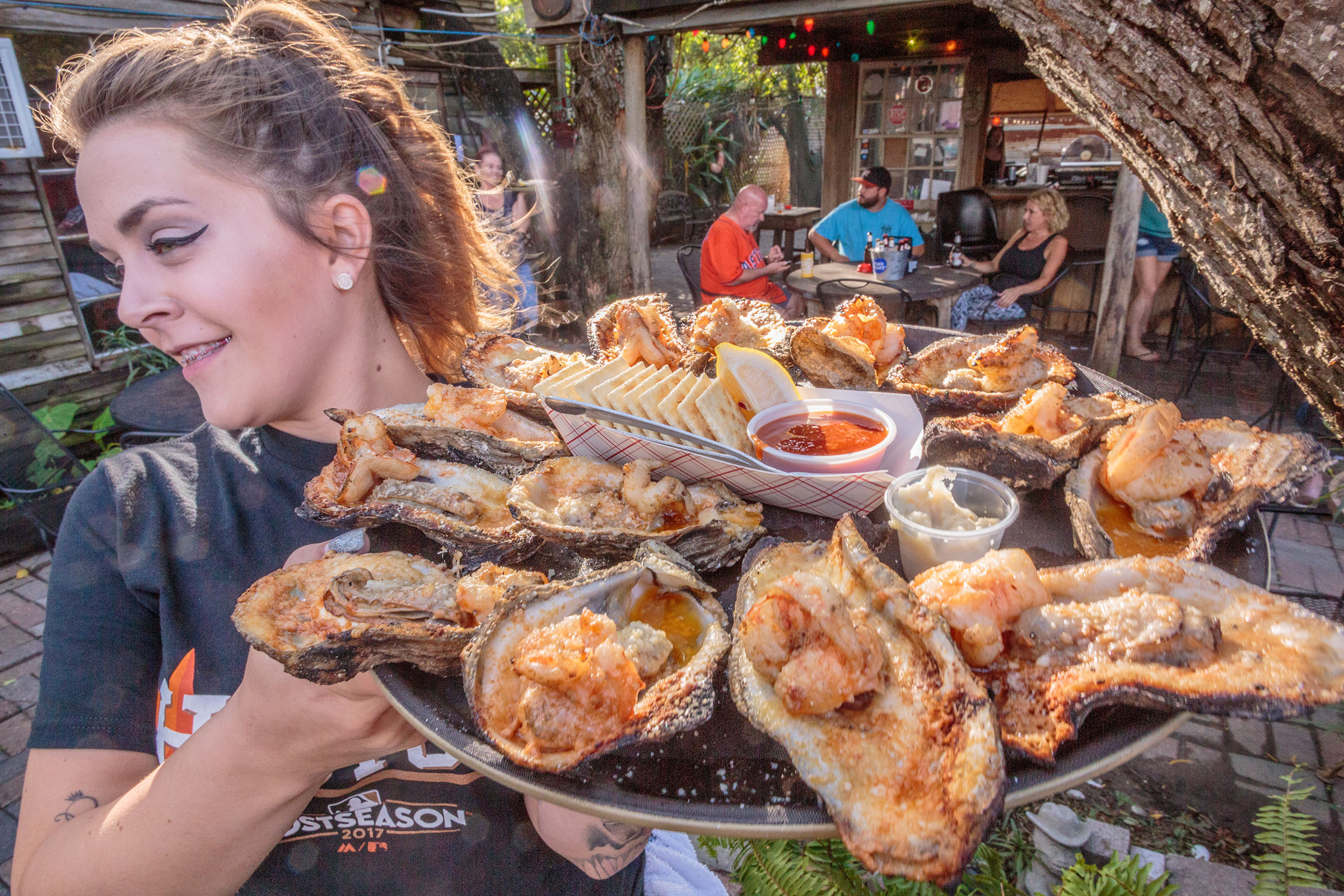
Oysters at Gilhooley’s Restaurant and Oyster Bar in San Leon. Photo by Will van Overbeek.
What looks like a slimy rock but is considered a culinary delicacy, lives as long as 20 years, and can change from male to female and back again? That would be an oyster, the only bivalve—an aquatic mollusk with a hinged shell—that builds reefs up to several feet high and acres across.
As we enter what is traditionally the best part of the year to eat oysters from the Gulf of Mexico, it seems like a good time to pry open some of the myths about them and separate fact from fallacy, starting with the myth about when to eat them.
Oysters are best eaten from September through April.
Well, oyster aficionados, you can rejoice. You no longer need to heed the old saying that you should only eat oysters during months with an “r” in them. That belief was due in part to a lack of widespread refrigeration, but it also reflected the fact that wild oysters are plumper and better to eat in winter months because during the summer, they put their energy into reproduction.
Oysters are a natural aphrodisiac.
Speaking of reproduction, there is no scientific evidence to back up the claim that oysters are an aphrodisiac. It may be assumed that oysters cause frisky behavior in humans because oysters are masters of reproduction: a single female produces up to 100 million eggs each year and a 25-acre reef produces 10 million adult oysters in about 18 months. They are good for you, though; according to Texas Sea Grant, a 3.5-ounce serving has 7 grams of protein and 100% of the vitamin B12, zinc, and copper you need every day as well as healthy doses of selenium, vitamin D, and omega-3 fatty acids.
Oyster habitats are disappearing.
One sad truth about oysters is, even with their astonishing reproductive ability, their habitats are disappearing—at least for now. As much as 85% of historic oyster habitat has been lost, and global wild oyster harvests have declined by 43% since 2000. “One of the worst things we ever did was dredging shells to build roads all along the coast,” says Larry McKinney, chair of Gulf strategies at the Harte Research Institute for Gulf of Mexico Studies at Texas A&M University Corpus Christi. That practice continued into the 1980s before the Texas Parks and Wildlife Department prohibited it.
On the plus side, Texas legalized oyster cultivation in 2019. Our oyster ranches grow eastern oysters (Crassostrea virginica), also known as the American, Atlantic, or Gulf Coast oyster. While wild oysters typically take at least 18 months to reach market size, once established, cultivated oysters are ready to eat in a year.
Oysters in the Gulf grow more quickly than in other places.
That also is a fact, thanks to year-round warm waters, says Tasha Breaux, a project manager at the Harte Research Institute. “That’s a benefit for restoration and aquaculture. They come back quickly when given a place to grow.”
Gulf oysters taste the best.
Now, Texans are known to take pride in anything made in the Lone Star State, and, yes, that carries over to Gulf oysters. But tasting the best? That is literally a matter of taste, but Texas oysters are worth bragging about. “A lot of people don’t realize how good they are,” Breaux says. “People lump Texas oysters in with all Gulf oysters, but their taste reflects where they are. Here in Texas, especially in the Mission Aransas estuary, the salinity can be quite high, and those oysters take on that flavor.”
You’ll find a pearl in every oyster.
The expression “the world is your oyster” comes from Shakespeare’s The Merry Wives of Windsor and equates to opening an oyster and finding a pearl, suggesting unlimited opportunities and a bright future. Before you get too excited, though, know that eastern oysters usually do not produce pearls. You may see something resembling one, Breaux says, but it likely will look more like a tiny rock than a gem you might put on a string and wear around your neck.
Oysters provide benefits beyond being tasty and healthy.
Definitely. Oysters keep the water in our bays clear, help protect shorelines from erosion, and provide habitat for many other creatures. “When you compare an oyster reef versus a bare bay bottom, it seems like about 50 times more abundant fauna,” Breaux says. “You see people fishing near reefs because that’s where the fish go, that’s where the shrimp go, and so on.”
Never eaten an oyster? Larry McKinney of the Harte Research Institute understands.
“When you look at one, I can’t blame someone for saying, ‘I’m not eating that,’” he says. “But the best way is just to do it. Find something you like on them, hot sauce or something else. At some point, you will be able to taste how the different locations give them a different taste. It was a brave soul who first ate an oyster, but once they did, they really started something.”
Read more about Gulf oysters in the October issue of Texas Highways, which hits newsstands starting on 9/19.








